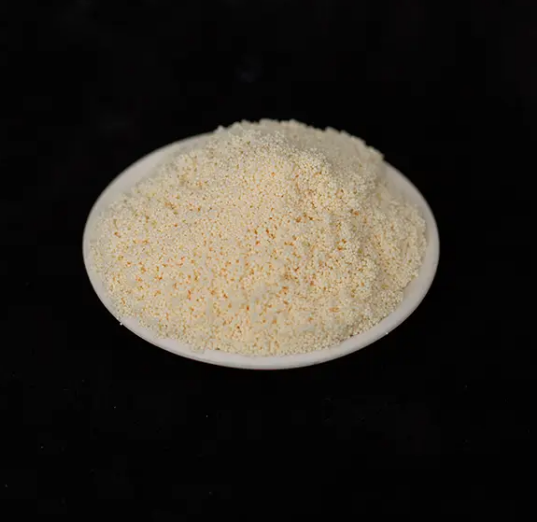



| Item | Index | |
|---|---|---|
| Appearance | Colorless, odorless, tasteless and lustrous transparent solid. | |
| Purity %≥ | 98 | |
| Melting point ℃ | 212 °C | |
| Resins | Polymer Matrix Structure | FunctionGroup | Ionic Form | Total Exchange Capacity meq/ml | Moisture Content | Particle Size mm | SwellingFB→Cl Max. | Shipping Weight (approx.) g/l |
|---|---|---|---|---|---|---|---|---|
| MA301 | Macroporous Ploy-styrene with DVB | Tertiary Amine | Free Base | 1.4 | 55-60% | 0.3-1.2 | 20% | 650-700 |
| MA301G | Macroporous Ploy-styrene with DVB | Tertiary Amine | Cl- | 1.3 | 50-55% | 0.8-1.8 | 20% | 650-690 |
| GA313 | Gel type Poly-acrylic with DVB | Tertiary Amine | Free Base | 1.4 | 55-65% | 0.3-1.2 | 25% | 650-700 |
| MA313 | Macroporous Poly-acrylic with DVB | Tertiary Amine | Free Base | 2.0 | 48-58% | 0.3-1.2 | 20% | 650-700 |
| Packing | in 25kg bags |
|---|---|
| Storage | - |
| Shipping | - |
Tel: 0086 25 52397805
Email: info@nj-finechem.com

| Common Names | Wang resin | ||
|---|---|---|---|
| Structure |  |
||
| CAS No. | 201058-08-4 | Boiling Point (℃) | 386.2ºC at 760 mmHg |
| Molecular Weight | 228.286 | Melting Point (℃) | N/A |
| Appearance | Off-white to beige beads | Vapor Specific Gravity | - |
| HS Code | 3909400000 | Flash Point (℃) | 175.2ºC |
| Solubility | - | Autoignition Temperature (℃) | - |
| Safety Phrases | 26-36/37/39-24/25 | ||
|---|---|---|---|
| RIDADR | 2211 | ||
| WGK Germany | 3 | ||
| Packaging Group | III | ||
| Hazard Class | - | ||
| SYMPTOMS | PREVENTION | FIRST AID | |
| Inhalation | poisonous | wear a mask | fresh air,keep breath comfortable |
| Skin | skin burn | wear protective clothing | Remove all soiled clothing and wash your skin with water. |
| Eyes | eye injury | wear goggles | Rinse slowly and gently with water for a few minutes |
| Ingestion | poisonous | Do not eat, drink or smoke while using this product | Call a POISON CENTRE or doctor |

What is Weak Base Anion Exchange Resin?
Weakly basic anion exchange resin: this kind of resin contains weakly basic groups, such as primary amino group (also known as primary amino group) – NH2, secondary amino group (secondary amino group) – NHR, or tertiary amino group (tertiary amino group) – NR2. They can dissociate Oh – in water and are weakly basic. In most cases, the resin adsorbs the whole other acid molecules in the solution. It can only work under neutral or acidic conditions (such as pH 1-9). It can be regenerated with Na2CO3 and NH4OH.
How is Weak Base Anion Exchange Resin stored and distributed?
Weak base anion exchange resin can not be stored in the open air, the temperature of the storage place is 0-40 ℃, when the temperature of the storage place is slightly lower than 0 ℃, the bag should be added to the clarification of saturated brine, soak the resin. In addition, when the storage temperature is too high, it will not only make the resin easy to dehydrate, but also accelerate the degradation of the resin. Once the resin loses water, it can not be used directly with water, but can be soaked in clarified saturated saline water, and then gradually diluted with water to wash away the salt, and it should be kept moist during storage.
What is Weak Base Anion Exchange Resin used for?
Capable of removing inorganic and organic acids in the production of citric acid, malic acid, and
antibiotics.
Effectively adsorbs and desorbs organic substances and has a high resistance to organic fouling.
Effective demineralization of incoming water, the amount of dissolved solids in water that has been
demineralized can be less than 10mg/l.
In the industrial field, desalination of industrial water.
Decolorization treatment in food, pharmaceutical and other fields.
Removal of hexavalent chromium from electroplating wastewater
Removal of COD in wastewater solution treatment
Reduction of ionic charge of strong base anion